2023届高三英语二轮复习:定语从句语法课件(33张ppt)
文档属性
| 名称 | 2023届高三英语二轮复习:定语从句语法课件(33张ppt) |  | |
| 格式 | pptx | ||
| 文件大小 | 196.3KB | ||
| 资源类型 | 教案 | ||
| 版本资源 | 通用版 | ||
| 科目 | 英语 | ||
| 更新时间 | 2022-11-21 10:49:44 | ||
图片预览

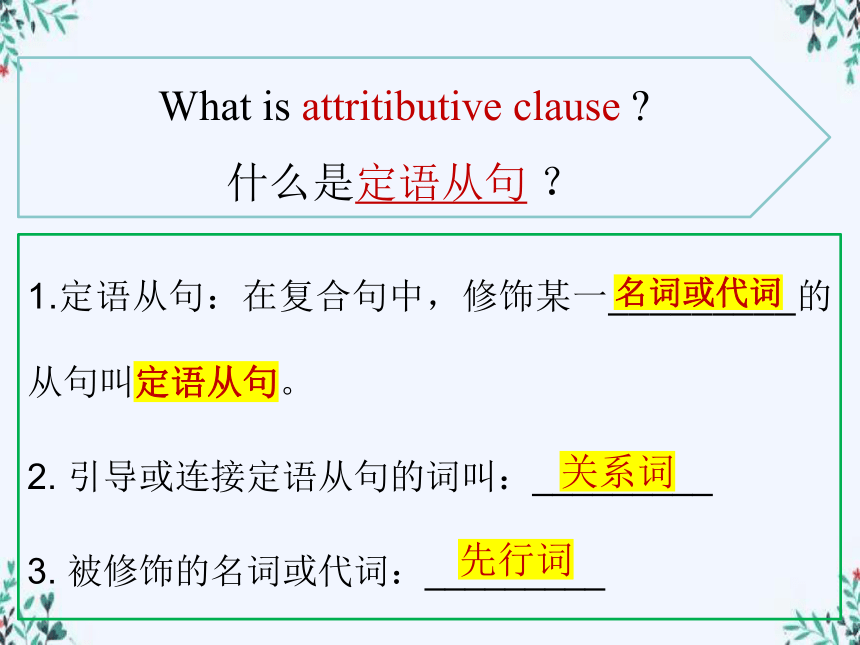
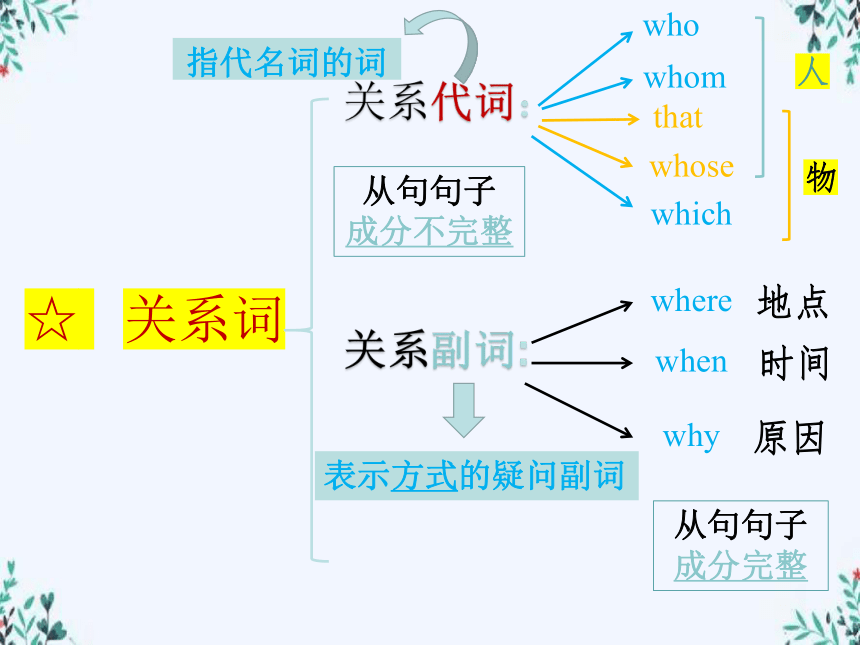
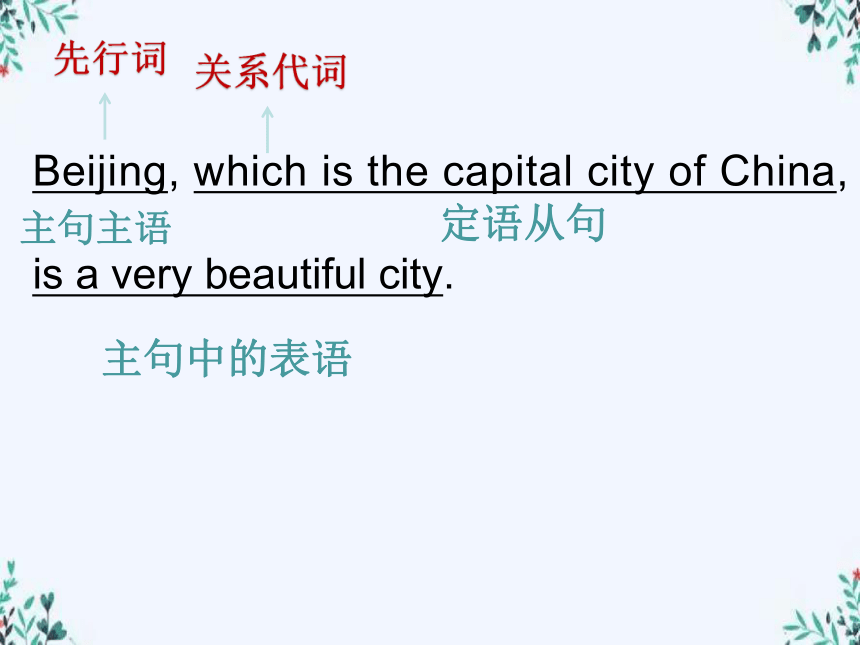
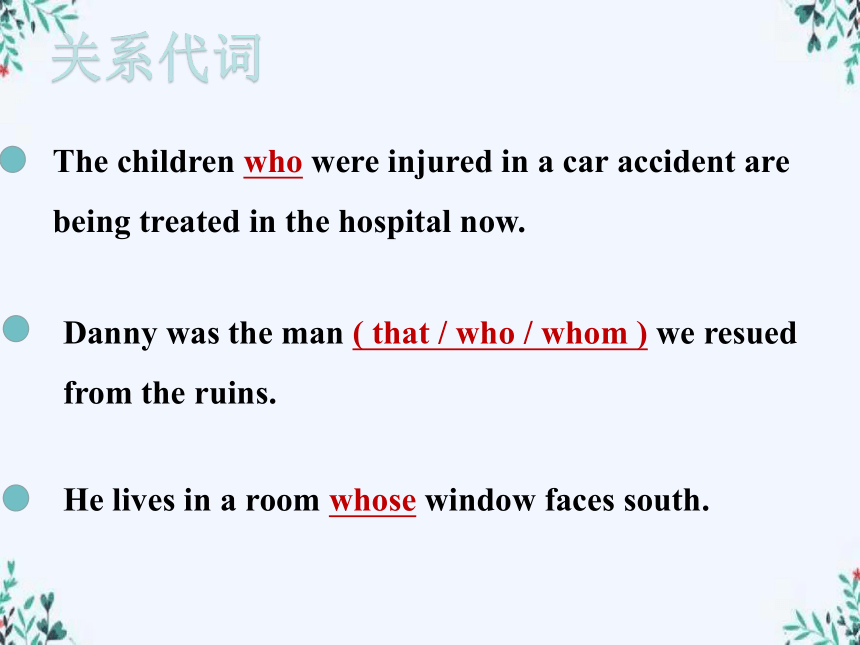
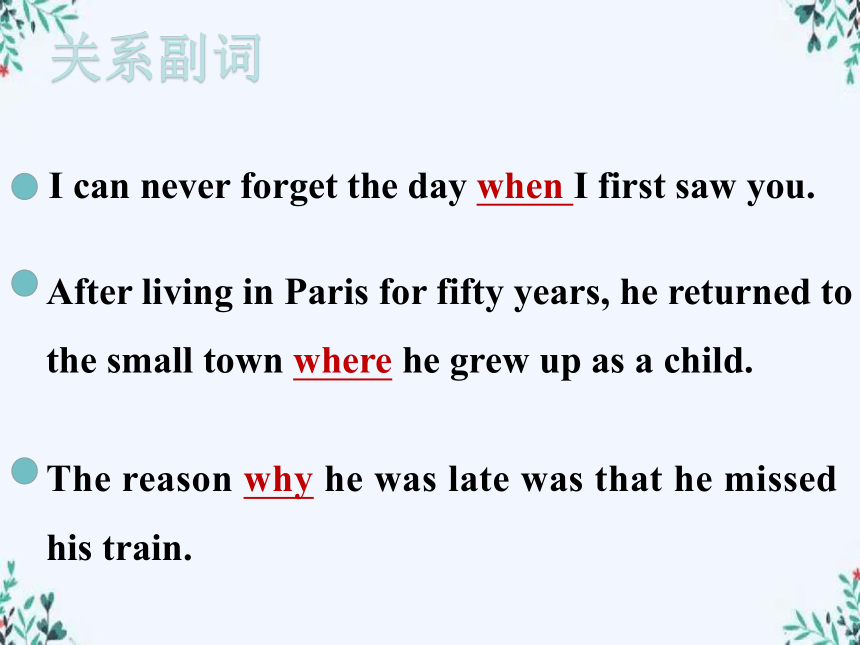
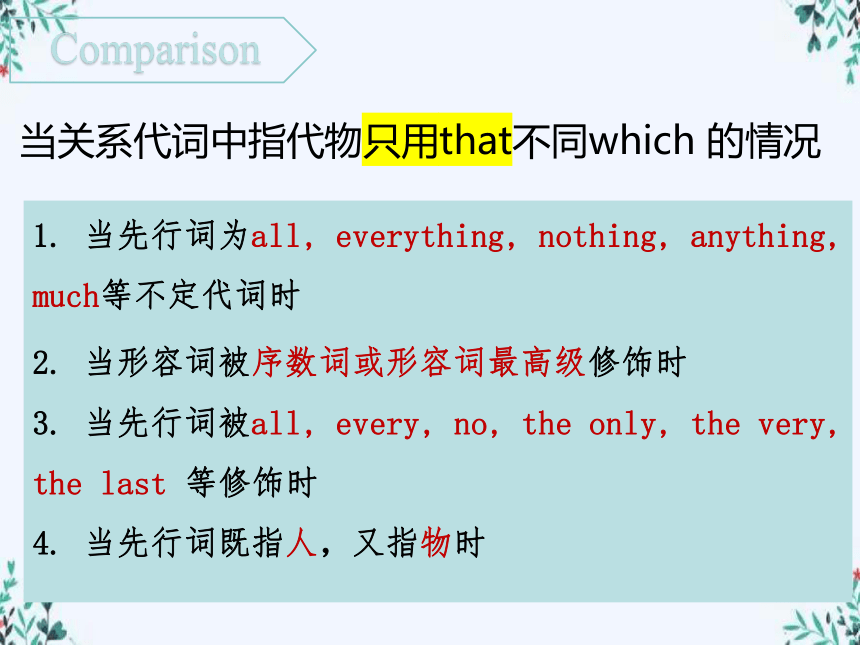

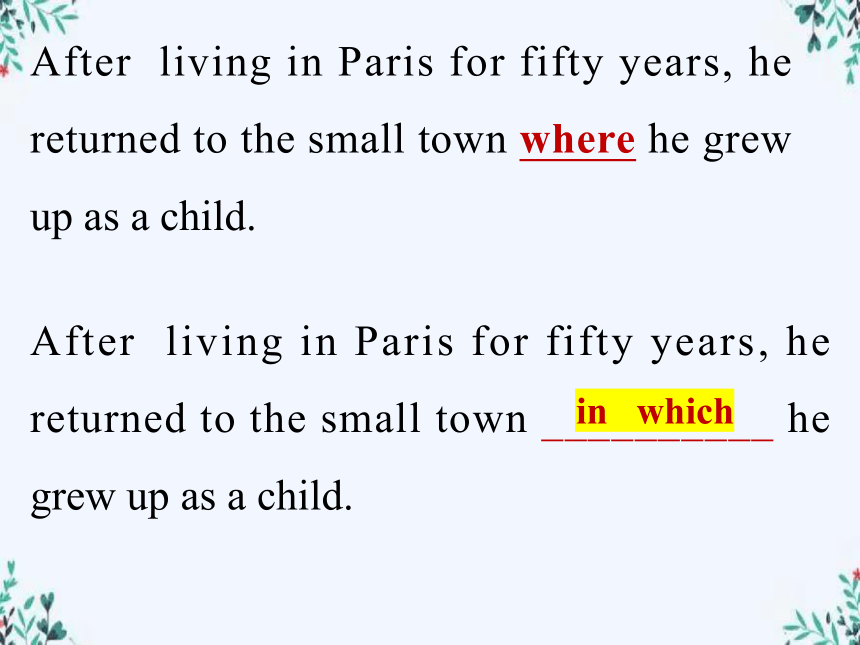
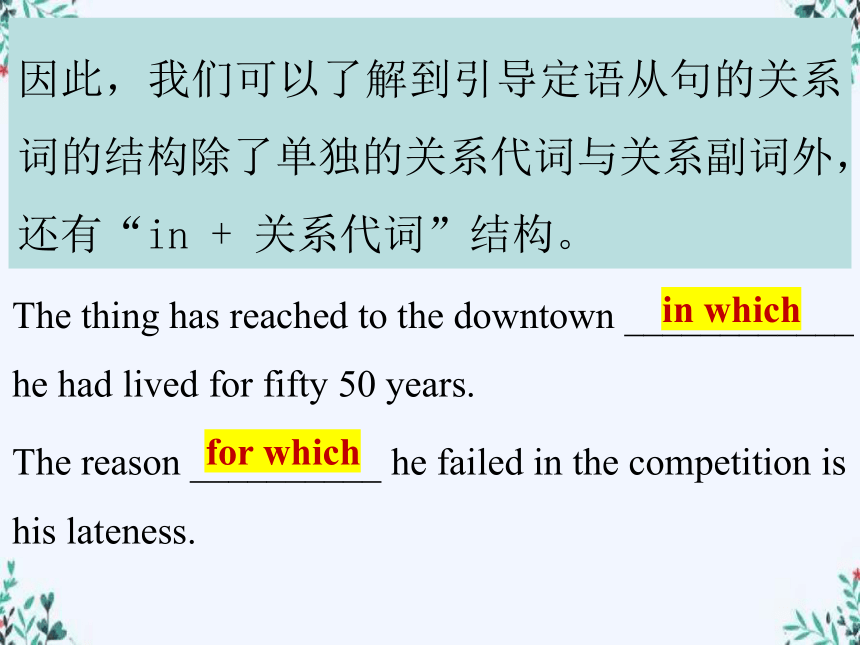

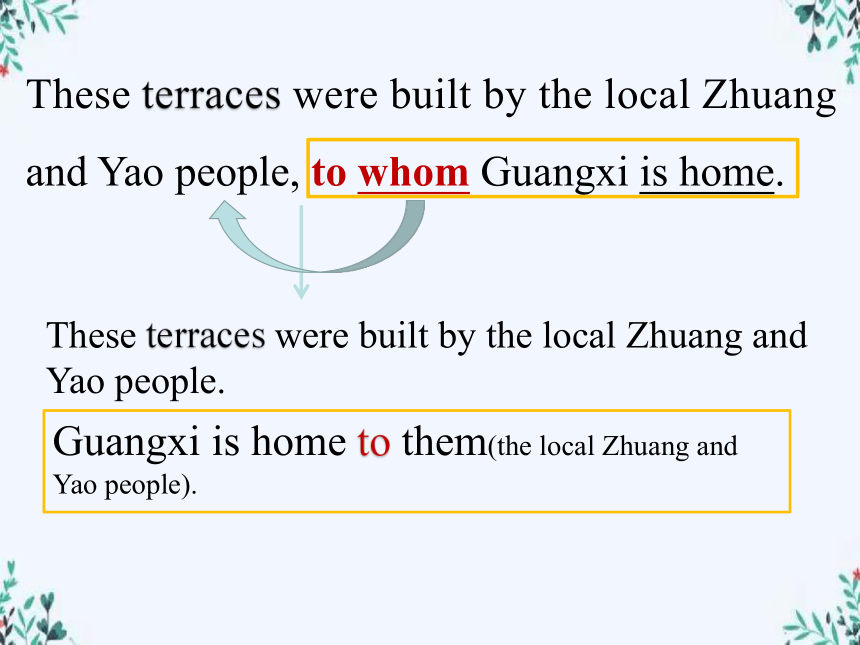
文档简介
(共33张PPT)
定语从句专项3
Revision Attributive Clause
1.定语从句:在复合句中,修饰某一_________的从句叫定语从句。
2. 引导或连接定语从句的词叫:_________
3. 被修饰的名词或代词:_________
What is attritibutive clause
什么是定语从句 ?
名词或代词
关系词
先行词
☆ 关系词
关系代词:
关系副词:
指代名词的词
who
whom
that
which
whose
人
物
where
when
why
表示方式的疑问副词
地点
时间
原因
从句句子
成分不完整
从句句子
成分完整
Beijing, which is the capital city of China, is a very beautiful city.
主句中的表语
主句主语
定语从句
先行词
关系代词
关系代词
The children who were injured in a car accident are being treated in the hospital now.
Danny was the man ( that / who / whom ) we resued from the ruins.
He lives in a room whose window faces south.
I can never forget the day when I first saw you.
After living in Paris for fifty years, he returned to the small town where he grew up as a child.
关系副词
The reason why he was late was that he missed his train.
Comparison
当关系代词中指代物只用that不同which 的情况
2. 当形容词被序数词或形容词最高级修饰时
3. 当先行词被all, every, no, the only, the very, the last 等修饰时
4. 当先行词既指人,又指物时
1. 当先行词为all, everything, nothing, anything, much等不定代词时
Please discuss it with your partners
Can you think about it
Comparison
当关系代词中指代物只用which不用that 的情况
当关系词前面有介词,即引导含有介词伴随其后的先行词(物)的定语从句时只能用which, 而不用that
After living in Paris for fifty years, he returned to the small town where he grew up as a child.
After living in Paris for fifty years, he returned to the small town __________ he grew up as a child.
in which
因此,我们可以了解到引导定语从句的关系词的结构除了单独的关系代词与关系副词外,还有“in + 关系代词”结构。
The thing has reached to the downtown ____________ he had lived for fifty 50 years.
The reason __________ he failed in the competition is his lateness.
in which
for which
定语从句(3)
“介词+关系代词”
New Lesson
These terraces were built by the local Zhuang and Yao people, to whom Guangxi is home.
These terraces were built by the local Zhuang and Yao people.
Guangxi is home to them(the local Zhuang and Yao people).
Building the terraces therefore meant that they could increase the areas in which they could grow rice.
Building the terraces therefore meant that they could increase the areas.
They could grow rice in the areas.
共同部分
= where
14
Read the following sentences and combine them into one sentence.
There comes Tom.
I have been waiting for him for an hour.
There comes Tom, for whom I have been waiting for an hour.
汤姆来了,我等了他一个小时。
him 作for的宾语
He handed me a pen.
I wrote down his phone number with it.
(it作介词with的宾语)
He handed me a pen, with which I wrote down his phone number.
他递给我一支钢笔,我用它写下了他的电话号码。
介词+关系代词(指人-- whom, 指物-- which)
“介词+关系代词”
引导的定语从句
一、关系代词的确定
二、关系代词前介词选择的原则
三、“介词+关系代词”的几种常见结构
关系代词的确定
If you have anything on which you want my opinions, feel free to see me.
“介词+关系代词”结构既可以引导限制性定语从句,也可以引导非限制性定语从句。在此结构中,关系代词只能用which(指物)或whom(指人),即“介词+which/whom”,并且不能省略。
☆
I took a photo of the students, among whom was seated a teacher.
“介词+关系代词(which/whom)”中介词的选择要遵循“一先、二动、三意义”的原则。
The factory in which I’m working mainly produces computers.
我工作所在的工厂主要生产电脑。
(in which代替 in the factory,“在工厂里”用介词in)
关系代词前介词选择的原则
“一先”,即根据先行词和介词的习惯搭配来确定介词。
2.“二动”,即根据定语从句中的谓语动词或形容词与介词的习惯搭配来确定介词。
In the dark street, there wasn't a single person _________she could turn for help.
在漆黑的街道上,她没有一个人可以求助。
to whom
to whom 代替 to a person
turn to sb for help“向某人求助”
“三意义”,即根据定语从句的意义来确定介词。
In the office, I never seem to have time until after 5:30 pm, __________ time many people have gone home.
在办公室里,我要到下午5:30之后才能有点空闲,到那时,许多人已经回家了。
by which
21
介词的位置
介词若与从句中的动词词组有关,可置于关系代词前,也可置于动词后,但若此介词与动词为固定词组,则此介词一般不前置。
Yesterday we paid a visit to the house in which Lu Xun once lived.
Yesterday we paid a visit to the house which Lu Xun once lived in.
This is the very pen that I’m looking for.
look for是固定词组,介词for不前置
22
介词+关系代词”的其他相关知识
在限制性定语从句中,介词前置时,关系代词不能用that,且不能省略;若介词后置,则可以用that,也可以省略。
This is the school in which I studied 3years ago.
This is the school (that/which) I studied in 3 years ago.
1.“介词+which”在定语从句中,可作时间、地
点和原因状语,代替相应的关系副词when, where和why.
I'll never forget the days _________ (=when) we studied together.
我永远忘不了我们一起学习的日子。
The police searched the house _________(= where) the thief had stayed.
警察搜查了那个小偷待过的房子。
“介词+关系代词”的几种常见结构
on which
in which
这个结构中,代词常常为 all,each,one,
many, much, most, some, none,both等,
“代词+of+which/whom”通常在定语从句中作主语,说明整体中的一部分。有时候也可把“of+which/whom”置于代词或数词前。
He has lots of hobbies, _____________ is swimming.
他有很多爱好,其中之一是游泳。
one of which
2.“代词/数词+of+which/whom”引导定语从句。
3.“the十名词+of which/whom”引导定语从句
这个结构中,of which/whom 充当定语,修饰前面的名词,整个结构相当于“whose十名词”引导的定语从句。
I saw some trees, ______________ (=whose leaves) were yellow with disease.
我看见一些树,它们的叶子因害病而发黄。
the leaves of which
真题在线
(2019全国Ⅰ卷)They rose in the ranks not by being friendly but by smoking cigarettes, breaking rules and playing jokes on the others, among____ I stood found myself.
A.that B. which C. who D. whom
(2019年全国Ⅱ卷) He likes that he can sit and check his phone in peace or chat up the barkeeper with ______ he’s first-name basis if he wants to have a little interaction.
A.that B. them C. whom D. which
D
C
(2019年全国Ⅱ卷) First, I wanted to be a fireman, ______ uniform looked so cool.
A.that B. which C. whose D. whom
(2019年全国Ⅲ卷) Lin-Manuel Miranda wrote this musical about Alexander Hamilton, _______ the birth of America is presented as an immigrant story.
A. in which B. for which C. from which D. of which
C
the uniform of whom
A
【课堂小结】
小结
“介词+关系代词”结构
关系 代词 人 whom
物 which
介 词 根据定语从句中的谓语或形容词来确定
根据先行词来确定
根据定语从句所表达的意义来确定
有时需要同时考虑动词和介词的搭配关系及介词和先行词的搭配关系
限制性定语从句与非限制性定语从句
从句是先行词不可缺少的定语,如果省去,主句的意思就会不完整或不明确。
限制性定语从句 非限制性定语从句
从句与先行词的关系
标 点
修饰
翻译
从句只是对先行词的附加说明,如果省去,主句的意思仍然清楚或完整。
从句和主句之间不用逗号分开
从句和主句之间通常用逗号分开
从句只修饰一个名词或代词
可以修饰一个名词或代词也可修饰整个主句
定语从句译在被修饰词的前面
定语从句通常被译成另一个独立的句子
He has a brother who is a physicist.
他有一个当物理学家的哥哥。
He has a brother, who is a physicist.
他有一个哥哥,他是一个物理学家。
Example Show
He returned all the books which are written in English.
他归还了所有用英语写的书。
He returned all the books, which are written in English.
他归还了所有的书,那些书都是用英语写的。
当先行词为专有名词或是世界上独一无二的名词时,一般用非限定性定语从句修饰。
The sun, which gives us light, is very big.
Special Case
定语从句专项3
Revision Attributive Clause
1.定语从句:在复合句中,修饰某一_________的从句叫定语从句。
2. 引导或连接定语从句的词叫:_________
3. 被修饰的名词或代词:_________
What is attritibutive clause
什么是定语从句 ?
名词或代词
关系词
先行词
☆ 关系词
关系代词:
关系副词:
指代名词的词
who
whom
that
which
whose
人
物
where
when
why
表示方式的疑问副词
地点
时间
原因
从句句子
成分不完整
从句句子
成分完整
Beijing, which is the capital city of China, is a very beautiful city.
主句中的表语
主句主语
定语从句
先行词
关系代词
关系代词
The children who were injured in a car accident are being treated in the hospital now.
Danny was the man ( that / who / whom ) we resued from the ruins.
He lives in a room whose window faces south.
I can never forget the day when I first saw you.
After living in Paris for fifty years, he returned to the small town where he grew up as a child.
关系副词
The reason why he was late was that he missed his train.
Comparison
当关系代词中指代物只用that不同which 的情况
2. 当形容词被序数词或形容词最高级修饰时
3. 当先行词被all, every, no, the only, the very, the last 等修饰时
4. 当先行词既指人,又指物时
1. 当先行词为all, everything, nothing, anything, much等不定代词时
Please discuss it with your partners
Can you think about it
Comparison
当关系代词中指代物只用which不用that 的情况
当关系词前面有介词,即引导含有介词伴随其后的先行词(物)的定语从句时只能用which, 而不用that
After living in Paris for fifty years, he returned to the small town where he grew up as a child.
After living in Paris for fifty years, he returned to the small town __________ he grew up as a child.
in which
因此,我们可以了解到引导定语从句的关系词的结构除了单独的关系代词与关系副词外,还有“in + 关系代词”结构。
The thing has reached to the downtown ____________ he had lived for fifty 50 years.
The reason __________ he failed in the competition is his lateness.
in which
for which
定语从句(3)
“介词+关系代词”
New Lesson
These terraces were built by the local Zhuang and Yao people, to whom Guangxi is home.
These terraces were built by the local Zhuang and Yao people.
Guangxi is home to them(the local Zhuang and Yao people).
Building the terraces therefore meant that they could increase the areas in which they could grow rice.
Building the terraces therefore meant that they could increase the areas.
They could grow rice in the areas.
共同部分
= where
14
Read the following sentences and combine them into one sentence.
There comes Tom.
I have been waiting for him for an hour.
There comes Tom, for whom I have been waiting for an hour.
汤姆来了,我等了他一个小时。
him 作for的宾语
He handed me a pen.
I wrote down his phone number with it.
(it作介词with的宾语)
He handed me a pen, with which I wrote down his phone number.
他递给我一支钢笔,我用它写下了他的电话号码。
介词+关系代词(指人-- whom, 指物-- which)
“介词+关系代词”
引导的定语从句
一、关系代词的确定
二、关系代词前介词选择的原则
三、“介词+关系代词”的几种常见结构
关系代词的确定
If you have anything on which you want my opinions, feel free to see me.
“介词+关系代词”结构既可以引导限制性定语从句,也可以引导非限制性定语从句。在此结构中,关系代词只能用which(指物)或whom(指人),即“介词+which/whom”,并且不能省略。
☆
I took a photo of the students, among whom was seated a teacher.
“介词+关系代词(which/whom)”中介词的选择要遵循“一先、二动、三意义”的原则。
The factory in which I’m working mainly produces computers.
我工作所在的工厂主要生产电脑。
(in which代替 in the factory,“在工厂里”用介词in)
关系代词前介词选择的原则
“一先”,即根据先行词和介词的习惯搭配来确定介词。
2.“二动”,即根据定语从句中的谓语动词或形容词与介词的习惯搭配来确定介词。
In the dark street, there wasn't a single person _________she could turn for help.
在漆黑的街道上,她没有一个人可以求助。
to whom
to whom 代替 to a person
turn to sb for help“向某人求助”
“三意义”,即根据定语从句的意义来确定介词。
In the office, I never seem to have time until after 5:30 pm, __________ time many people have gone home.
在办公室里,我要到下午5:30之后才能有点空闲,到那时,许多人已经回家了。
by which
21
介词的位置
介词若与从句中的动词词组有关,可置于关系代词前,也可置于动词后,但若此介词与动词为固定词组,则此介词一般不前置。
Yesterday we paid a visit to the house in which Lu Xun once lived.
Yesterday we paid a visit to the house which Lu Xun once lived in.
This is the very pen that I’m looking for.
look for是固定词组,介词for不前置
22
介词+关系代词”的其他相关知识
在限制性定语从句中,介词前置时,关系代词不能用that,且不能省略;若介词后置,则可以用that,也可以省略。
This is the school in which I studied 3years ago.
This is the school (that/which) I studied in 3 years ago.
1.“介词+which”在定语从句中,可作时间、地
点和原因状语,代替相应的关系副词when, where和why.
I'll never forget the days _________ (=when) we studied together.
我永远忘不了我们一起学习的日子。
The police searched the house _________(= where) the thief had stayed.
警察搜查了那个小偷待过的房子。
“介词+关系代词”的几种常见结构
on which
in which
这个结构中,代词常常为 all,each,one,
many, much, most, some, none,both等,
“代词+of+which/whom”通常在定语从句中作主语,说明整体中的一部分。有时候也可把“of+which/whom”置于代词或数词前。
He has lots of hobbies, _____________ is swimming.
他有很多爱好,其中之一是游泳。
one of which
2.“代词/数词+of+which/whom”引导定语从句。
3.“the十名词+of which/whom”引导定语从句
这个结构中,of which/whom 充当定语,修饰前面的名词,整个结构相当于“whose十名词”引导的定语从句。
I saw some trees, ______________ (=whose leaves) were yellow with disease.
我看见一些树,它们的叶子因害病而发黄。
the leaves of which
真题在线
(2019全国Ⅰ卷)They rose in the ranks not by being friendly but by smoking cigarettes, breaking rules and playing jokes on the others, among____ I stood found myself.
A.that B. which C. who D. whom
(2019年全国Ⅱ卷) He likes that he can sit and check his phone in peace or chat up the barkeeper with ______ he’s first-name basis if he wants to have a little interaction.
A.that B. them C. whom D. which
D
C
(2019年全国Ⅱ卷) First, I wanted to be a fireman, ______ uniform looked so cool.
A.that B. which C. whose D. whom
(2019年全国Ⅲ卷) Lin-Manuel Miranda wrote this musical about Alexander Hamilton, _______ the birth of America is presented as an immigrant story.
A. in which B. for which C. from which D. of which
C
the uniform of whom
A
【课堂小结】
小结
“介词+关系代词”结构
关系 代词 人 whom
物 which
介 词 根据定语从句中的谓语或形容词来确定
根据先行词来确定
根据定语从句所表达的意义来确定
有时需要同时考虑动词和介词的搭配关系及介词和先行词的搭配关系
限制性定语从句与非限制性定语从句
从句是先行词不可缺少的定语,如果省去,主句的意思就会不完整或不明确。
限制性定语从句 非限制性定语从句
从句与先行词的关系
标 点
修饰
翻译
从句只是对先行词的附加说明,如果省去,主句的意思仍然清楚或完整。
从句和主句之间不用逗号分开
从句和主句之间通常用逗号分开
从句只修饰一个名词或代词
可以修饰一个名词或代词也可修饰整个主句
定语从句译在被修饰词的前面
定语从句通常被译成另一个独立的句子
He has a brother who is a physicist.
他有一个当物理学家的哥哥。
He has a brother, who is a physicist.
他有一个哥哥,他是一个物理学家。
Example Show
He returned all the books which are written in English.
他归还了所有用英语写的书。
He returned all the books, which are written in English.
他归还了所有的书,那些书都是用英语写的。
当先行词为专有名词或是世界上独一无二的名词时,一般用非限定性定语从句修饰。
The sun, which gives us light, is very big.
Special Case
